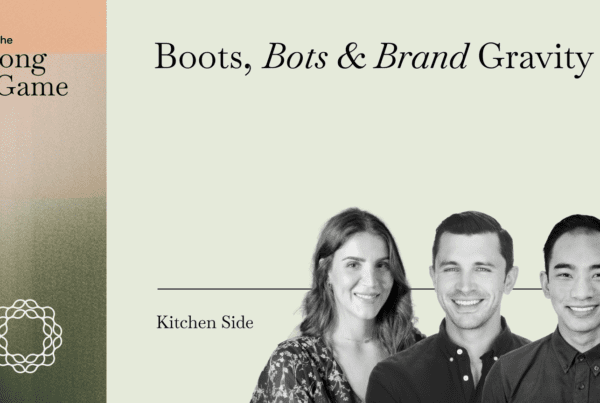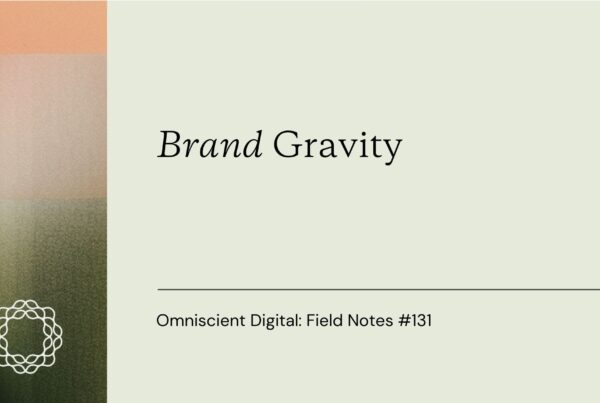
Content marketing and SEO usually end up in the same basket of conversation but are served as distinct (yet compatible) dishes at mealtime.
Content marketing is a broad umbrella that includes many things, such as thought leadership, customer education content, and blogging for SEO.
Sometimes SEO and content marketing are pitted against each other. “Write for humans, not for search engines,” one might advise.
This article — a deliberately staunch take — will explain why this dichotomy is silly, and why SEO should play a factor in *all* of your blogging efforts whether searchability is the primary goal or not.
Content Marketing SEO: What is SEO-Driven Content?
First off, let’s get our definitions in place.
SEO-driven content (otherwise known as SEO content marketing or content marketing SEO) is a type of content with the primary purpose of ranking for search queries.
Essentially, you can look at a blog post as a “product,” and SEO is an acquisition strategy for that product that leverages search engines as a distribution channel. Viral content or social media content marketing may leverage social platforms such as Twitter, Facebook, LinkedIn, or Pinterest to “acquire users” to read your content.
Content written without intent tends to be ineffective.
In our product analogy, it’s like saying “build it, and they’ll come,” which is concretely untrue in the vast majority of cases.
If a tree falls in the forest, but no one is around to hear it, does it make a sound? Likewise, if you write the most beautiful and impressive blog post in the world, and no one can read it or find it, does it make an impact?
Unfortunately, infographics compiled by Supple show that just 0.78% of Google searchers click the second-page results.
I want to stop here for a second, and say that I’m a content quality purist.
As proof, I’ll point you to these two articles I’ve written lambasting “cheap content” and the noise unleashed on the internet. On my personal site, I spend many months and hundreds of hours crafting some of my blog posts. At CXL, I aimed to produce the “best article in the world” on a given topic (you can argue whether or not I had achieved that goal, but the goal was in place).
I say this only to tell you I’m not here to say all content marketing should be robotically driven by keyword research and Clearscope. You’ve gotta write shit that people want to read. Hopefully it’s useful and entertaining, too.
In any case, quality means nothing if no one reads the article. Therefore, the idealist has to meet the pragmatist, who says “hey, let’s bring this tree out of the damn forest and into the town square so people can get a look at it.” Or cut a beautiful trail leading to the tree. Or something like that.
In SEO content marketing, you typically align topics with a keyword and optimize the written word to rank for that keyword. If I wanted to rank for “content marketing SEO,” I may drop that keyword several times in the article itself, add it in the title tag directly, and make my URL slug something like /content-marketing-seo/.
This is so people can hear the proverbial tree when it falls. I’m hoping, explicitly, that people find my article via search engines and that I answer their query when they search “content marketing SEO” or any of its variants.
Writing for Humans vs Algorithms, and Why This is a False Dichotomy
“Write for humans, not for robots,” is one of those things you hear over and over again. Like “content quality vs quantity,” or “incremental vs innovating a/b testing,” this is an obstinate debate that never ceases to rage on.
And worse, the virtuous answer (what people say) is different than the effective answer (what people do).
Stated vs revealed preferences again rears its head to say that most people in the real world are “writing for robots.” I say that having seen the kitchen side of many businesses. Most of ‘em are plugging keywords and praying.
Here’s the rub, though: humans are the ones using search engines. If you’re writing for search engines, you’re also writing for humans.
In fact, on a long enough time horizon, your incentives and Google’s are theoretically similar: to provide the best possible answer to a searcher’s question. Let me avoid the argument right now as to whether or not Google actually honestly does that (they have clearly done some questionable things with regards to content).
But all in all, if you write the best possible answer for searchers, you’re likely to rank better (at least in theory).
How I Write SEO-Driven Content for Humans
Here’s how I do it:
- I find a topic to write about (let’s say, “why content should be written with SEO in mind”)
- This is usually driven by my own intuition or customer insights and pain points. For my own website, it’s usually what I feel like writing about. For clients, it’s usually driven by qualitative research, surveys, interviews, and pain point analysis.
- I may map this to a keyword before writing, in which case, it gets added to my barbell-shaped content roadmap.
- I write the article, heeding the topic, not necessarily the keyword (in this example, writing an essay that seeks to persuade those not keen on ‘SEO content’ or ‘writing for robots,’ that it is indeed effective and pure to do so)
- I edit the article and map it to a keyword (lo and behold, I found that “content marketing SEO” gets 350 searches a month according to Ahrefs). I use Clearscope, Ahrefs, and other SEO tools to make sure that my topic is optimized for a keyword people are already searching for.
First, I usually search a couple phrases that seem to capture my idea about the topic I want to write about:
Then I pick a few of the URLs that rank, and I see which keywords they rank for using Ahrefs:
I pick one of those, and use it to optimize the piece (after it’s already written “for humans”). For this round of edits, I use Clearscope:
Voila! I found a way to write both for humans and for search engines. Not a dichotomy.
Search Engines are a Veritable Gold Mine of Customer Insights
Let’s say you’re not even worried about distribution.
You’ve already got a massive email list, or you know you can get traction on Reddit or Hacker News. Or maybe you’re writing your articles solely for customer education and retention purposes.
To get more concrete, let’s say you’re Butcher Box and you write recipes and educational articles for your existing subscribers to get more value out of the monthly meat box.
Even if you don’t care at all about using content as an acquisition channel, SEO can be another pool of data you can use to tap into your customers’ desires.
Just like using reader surveys, Hotjar polls, or other forms of qualitative data, keyword data from SEO tools like Ahrefs can let you tap into the minds of those who may be interested in your products.
First off, we can see that whether ButcherBox intended to drive new customer acquisition or not with their content, they’ve ranked for tons of keywords related to recipes. They are findable in search by many, many people who aren’t existing customers:
I’m not sure how they decide which recipes to publish. It may be from customer service inquiries. It may be that they hire a chef internally to advise and write the most delicious recipes and how to articles.
But they could just as easily swing over to the “competing domains” tool and see which other websites are ranking for similar keywords:
They could combine this with their own industry knowledge. For example, they probably have a lot of paleo and keto dieters as subscribers, so they could also look into paleoleap.com and paleogrubs.com.
Then they could plug these URLs into the “Content Gap” tool in Ahrefs:
Even if they don’t care at all to rank for any of these keywords in search, they now have a list of keyword ideas that they currently don’t rank for. They can also see the associated search volume, which is a proxy for demand and popularity. It’s highly likely that their customers, too, may be interested in topics and recipes like these:
SEO data is a treasure trove of insights. When you look at it as a barometer of what the public cares about and is curious about, it becomes remarkably less algorithmic and robotic.
Why Wouldn’t You Want to be Indexed?
Let’s continue with our ButcherBox examples.
Say they really can use the above list of keyword ideas to inform their publication schedule for their customer-driven content.
Even if the sole goal is to provide content to customers so that they churn less and retain for longer, what’s the harm in making these pieces *also* indexable via search.
The marginal effort is tiny, and the marginal value is huge.
Here’s the additional effort required for an example article:
- Decide the topic you want to write (“hunan chicken”)
- Hire expert writer or chef to put together content and recipe
- Look at what currently ranks for “hunan chicken” in Google to get a qualitative indication of what the user intent is and what the searcher expects in terms of the content that is delivered on page 1.
- Use SEO tool like Ahrefs, Clearscope, or SEMRush to map it to keywords and keyword variants
- Do minimal cosmetics, such as optimizing the title, URL slug, and adding some keyword variants in the content itself. These are largely unnoticeable to the average reader, unless they’re an SEO expert.
- Delight your customers with the content, and also rank in search to potentially acquire new users too.
For an incredibly small amount of effort, you open yourself up to some 66,000 searchers (and potential ButcherBox customers).
Makes no sense to me why you wouldn’t want to do that.
This isn’t always possible, of course.
I’ve written content with little tie-back to stuff that people are already searching, such as the idea that there’s no free lunch in content marketing, and about a topic I coined as “content marketing economics.”
Sometimes these can be mapped to existing concepts, though it can still be difficult to rank for them if your “answer” to the query is unique to what the searcher is likely looking for.
For example, Andrew Anderson wrote one of my favorite articles for CXL on the “narrative fallacy” and specifically, its application to conversion rate optimization.
The Narrative Fallacy is a well known topic, popularized by Nassim Taleb. But it’s broad in application, so the CRO-specific lens is unlikely to answer most searchers’ intent.
Still, the piece ranks for the keyword “narrative fallacy,” and probably drives some organic traffic because of that.
Similarly, if you’re writing for thought leadership or social shares or backlinks and you *can* map the same topic to a keyword, doing so provides incremental lifts, and over the long run, can be quite impactful. Here’s how Ross Hudgens put it:
One attribute of high-performing SEO-content teams: optimizing for every drop of long-term opportunity.
— Ross Hudgens (@RossHudgens) November 24, 2020
You should tie to relevant SV (even 50-100/mo) even if an article has links as a main KPI. That adds up, and they often high link-to-view ratios if tied to link-first ideas.
Where possible, map what you’re writing about to existing demand, and it’s all upside. Little downside, and little additional work. When it’s not possible, don’t worry too much about it and don’t let that limit your content calendar.
But when it’s possible, my view is, “why not?”
Conclusion
“Writing for humans vs writing for search engines” is a false dichotomy.
Search engines represent a predictable distribution channel, an amazing pool of audience insights, and an expected value that far outweighs the marginal cost of optimizing for a keyword when you’ve already planned and written a piece of content.
All content doesn’t need to be written with the explicit intent of driving SEO traffic, but if you bring that lens into your content marketing program and try to apply it wherever possible, you’ll unlock obvious and additional growth opportunities.


